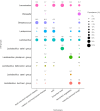The food-gut axis: lactic acid bacteria and their link to food, the gut microbiome and human health
- PMID: 32556166
- PMCID: PMC7391071
- DOI: 10.1093/femsre/fuaa015
The food-gut axis: lactic acid bacteria and their link to food, the gut microbiome and human health
Abstract
Lactic acid bacteria (LAB) are present in foods, the environment and the animal gut, although fermented foods (FFs) are recognized as the primary niche of LAB activity. Several LAB strains have been studied for their health-promoting properties and are employed as probiotics. FFs are recognized for their potential beneficial effects, which we review in this article. They are also an important source of LAB, which are ingested daily upon FF consumption. In this review, we describe the diversity of LAB and their occurrence in food as well as the gut microbiome. We discuss the opportunities to study LAB diversity and functional properties by considering the availability of both genomic and metagenomic data in public repositories, as well as the different latest computational tools for data analysis. In addition, we discuss the role of LAB as potential probiotics by reporting the prevalence of key genomic features in public genomes and by surveying the outcomes of LAB use in clinical trials involving human subjects. Finally, we highlight the need for further studies aimed at improving our knowledge of the link between LAB-fermented foods and the human gut from the perspective of health promotion.
Keywords: food microbiome; human microbiome; lactic acid bacteria; sprobiotics.
© FEMS 2020.
Figures




References
-
- Aguilar-Toalá JE, Garcia-Varela R, Garcia HSet al. . Postbiotics: An evolving term within the functional foods field. Trends Food Sci Technol. 2018;75:105–14.
-
- Alard J, Lehrter V, Rhimi Met al. . Beneficial metabolic effects of selected probiotics on diet-induced obesity and insulin resistance in mice are associated with improvement of dysbiotic gut microbiota. Environ Microbiol. 2016;18:1484–97. - PubMed
Publication types
MeSH terms
LinkOut - more resources
Full Text Sources
Other Literature Sources
Miscellaneous

